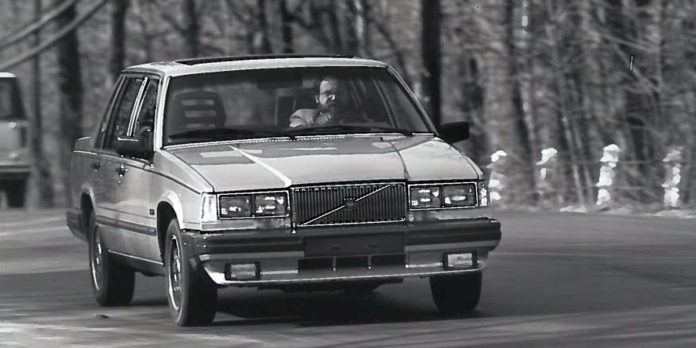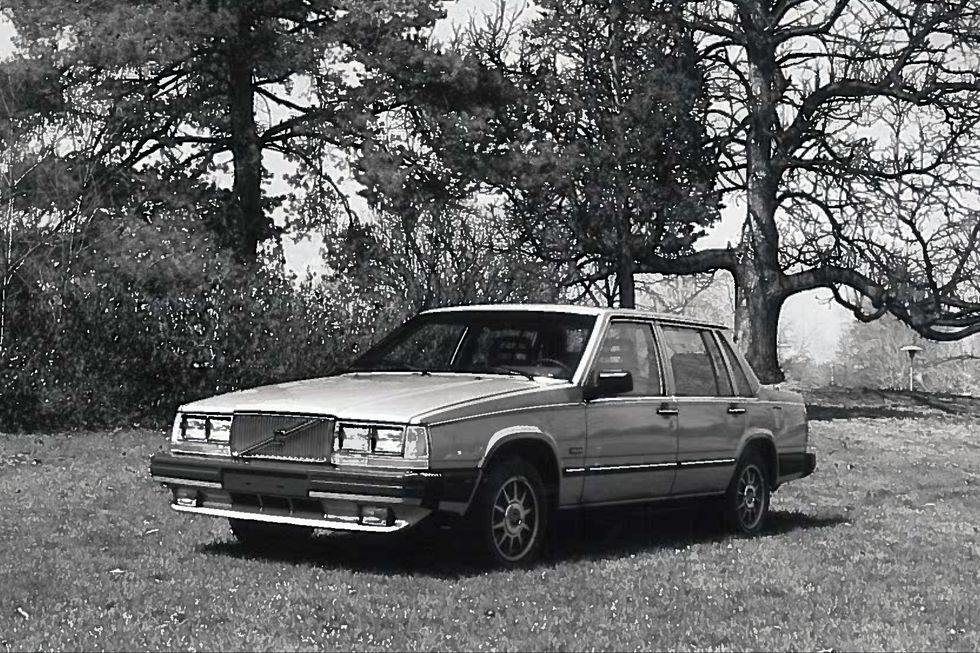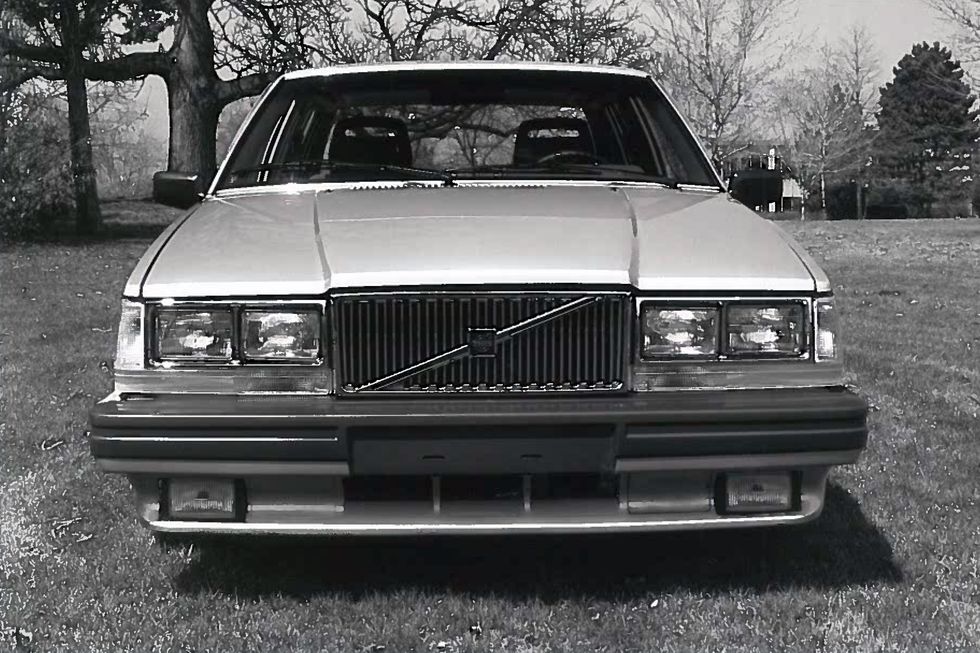From the July 1982 issue of Car and Driver.
When Volvos first rolled ashore in these United States just over 25 years ago, they were enthusiastically received because they reminded Americans of American cars. They looked like ’47 Fords, had the same sort of guts, and ran faster. There was an American temperament about the Volvo, albeit about 10 years behind what Detroit was doing in the marshmallow years of the late Fifties, and we Yanks welcomed Volvos in a way we never did the Saabs, Peugeots, English Fords, and Mercedes-Benzes of the time.
With the new 760GLE, you might say that Volvo is returning to its American ways. From the sedan’s squarish appearance, you might even say it’s the American car of the future, Volvo having taken GM’s creased-and-folded look one step further in the evolution. Could this be what GM will do next? And some would say it’s an improvement over the present A-body design because the Volvo is consistently sharp-cornered while the abruptness of the Celebrity-6000-Ciera-Century roofline is not faithfully continued in the lower body. In any case, if you turn the Volvo sideways, you see the same ramp nose, stiff rear-window angle, and high tail of the GM intermediates, and this look is rapidly becoming as familiar to Americans as the molded–Jell-O profile of the ’47 Ford was in Volvo’s early days.
The new Volvo is also virtually identical in size to the new GM A-body, which puts it right in the mainstream of American automobiles. Its length and width are comparable to the A-body dimensions within about an inch, though the Volvo is 2.7 inches taller and has 4.1 inches more wheelbase. The extra distance between the wheels keep the rear wheelhouses from biting into the corners of the rear seat. This is a downsized Volvo, 4.0 inches shorter and approximately 75 pounds lighter than the GLE it replaces, yet it’s still as big as—and a bit heavier than—the latest American intermediates. Early Volvos were relatively small cars; today’s are not.
Early Volvos made no pretension to luxury either. The 760GLE is a top-of-the-line model, the best Volvo’s got, a direct competitor with the bottom end of the Mercedes spectrum in Europe. Here it’s meant to tiptoe right up to the $20,000 mark (prices have yet to be announced) with a full load of equipment, including leather seats, climate control, AM/FM/cassette stereo, power windows, power sunroof, cruise control, central locking system, bun-warmer seats, etc., etc. That may or may not be your idea of royal treatment, but it sure leaves the ersatz-Ford days behind.
By the way, this new model replaces only the top-of-the-line CLE in the Volvo lineup, leaving the rest of the old-style range intact. Significantly, the 760 is also the only Volvo bereft of mud flaps, which could limit its appeal to traditionalists.
Peeling off the mud flaps is said to be an aerodynamic consideration. As a byproduct, it further Americanizes (perhaps de-Swedes is more accurate) the appearance. But once you look under the skin, the 760 is still very much a Volvo. There has been no following of the Americans to front drive. A longitudinal engine and a solid rear axle make up the drivetrain, just as before. There are two engine choices for America: the all-aluminum 2.8-liter V-6 that Volvo has been sharing with Renault and Peugeot for years, and the 2.4-liter inline-six diesel from Volkswagen, used by Volvo since 1980 but newly turbocharged for the 760. The turbo pumps output to 106 horsepower at 4800 rpm, making this a peppy little unit and one of the quickest diesels going. Transmission choices are limited to an automatic with the V-6, modernized with a button on the side of the shift handle to summon or reject the overdrive as the driver sees fit. The diesel can be backed up with either a three-speed automatic or a four-speed-plus-overdrive manual.
We sampled some of each in our testing: a manual diesel camouflaged by the older 260GLE body, and a 760GLE with a Euro-spec V-6 and an automatic. The diesel was about the right weight for an American-spec 760, and it was a fine runner, clocking 60 mph in 11.8 seconds. First gear is on the short side for anything but drag racing or trailer pulling; starting in second works fine in normal driving. Also, the turbo has considerable lag in routine traffic unless you keep the engine buzzing. But you always know when to expect results, because you can hear the compressor spooling up like some old J-47 under the hood.
The gas version was even quicker at 9.2 seconds to 60 mph, but this would be a very optimistic estimate of what to expect from a U.S.-spec version, since the car was down at least 60 pounds from the real thing and the engine was somewhat stronger. The automatic is sort of fun, however; it shifts firmly, both up and down, with none of the dithering between gears that we find on some of the allegedly more sophisticated boxes. The O.D. button is really only a lockout, however, allowing the driver to prevent the transmission from automatically selecting cruising gear. For efficiency’s sake it’s probably the best course to leave that button unpushed.
A quick look at the suspension finds MacPherson struts in front and an axle with trailing arms in back, the usual Volvo stuff. But in fact there are many minor revisions. Positive camber has been reduced to zero from 0.8 degree in front, and caster has been increased to 5.0 from 3.5 degrees, which should give the front tires more cornering bite and more feel in the steering. Alloy wheels with greater offset (in the direction that narrows the track) reduce the scrub radius to 28 mm from 37 mm. This still produces a positive radius (the tire contact patch outboard of a line through the upper and lower strut pivots), as opposed to the negative radius now fashionable on front-drive cars, but it should improve stability when one side of the car brakes across a slipperier surface than the other. Other changes include more accurate Ackermann angles and a rack-and-pinion gear mounted very low in the car. The payoff here is that the gear can be contained within the front crossmember for protection. Moreover, the slack that develops from wear in the gear will have minimal effect at the wheels.
Notable in the rear are a pair of axle-stabilizing torque links that attach to a huge bracket that, in turn, is rubber-isolated from the body. This is designed to improve ride without sacrificing control of the axle. There are also height-leveling shock absorbers.
How does all this reengineering feel to the driver? Fine. No problems. The 760 still acts like a Volvo, although it’s a bit crisper in the steering. And body-roll angles seem better managed. But this newest of Volvos is no Ford in the ride department. It’s decidedly direct in the way it transmits chuckholes, expansion strips, and individual pebbles to the seat of your pants. Real U.S.-spec cars will have low-rolling-resistance Pirelli P8s in the 185/65R-15 size; there were 195/60 P6s on the Euro car we drove. This will change the ride some, but there is little chance it will become plush.
Any plushness that you feel will be a product of the interior. Very likely, you will not be disappointed. Leather has a way of winning over almost everyone, and the 760’s broad horizontal pleats give it a sumptuous appearance (velour is standard on the Euro model). The front seats are typically Volvo, with adjustments for backrest angle, height, and lumbar stiffness. The cushions are somewhat softer and less supportive than those of the old GLE, which are as good as car seats come. Some of us liked the new seats less.
The 760’s rear seats are magnificent by any standard. They are extremely high-chair-height without a doubt and remarkably firm. The fact that the gas tank and rear suspension are right underneath has a lot to do with this. Nonetheless, though you are positioned high, where you can see forward over the driver’s shoulder, you still have plenty of head and knee room even if you’re a six-footer. The undersides of the front buckets have been scooped out for shoe clearance, so you can put your feet well forward. Everything is copacetic back there.
It’s not bad in front either. The low beltline eliminates the confining feeling of old Volvo interiors. The driving position is good. The dash is much like that of past Volvos, but more complex. Now there are five dials in the instrument cluster instead of three, and we are aware of more grilles in the vent system, creases in the molded padding, and knock-out panels for yet-to-be-added switches—more complex but not bewildering. There’s a continuity of style here that past Volvo owners will recognize immediately.
We’d like to see a few improvements in the 760. The body of this particular car is a bit clattery, and wind rush is conspicuous around the A-pillars. The ride doesn’t quite seem up to 1983 standards either. But perhaps these items will be less objectionable when the official U.S. models roll in this fall.
In any case, this new Volvo is not a car of surprises. Like its predecessors, it eschews the trendy in favor of a common-sense approach to car building. That theme has attracted a pretty substantial throng of buyers over the years, and if any of them have $20,000, it should continue to work with the 760.
Specifications
Specifications
1982 Volvo 760GLE
Vehicle Type: front-engine, rear-wheel-drive, 5-passenger, 4-door sedan
PRICE
As Tested: $20,000 (est.)
ENGINE
turbocharged SOHC diesel inline-6, iron block and aluminum head
Displacement: 145 in3, 2383 cm3
Power: 106 hp @ 4800 rpm
Torque: 139 lb-ft @ 2400 rpm
TRANSMISSION
4-speed manual
CHASSIS
Suspension, F/R: struts/trailing arms
Brakes, F/R: 10.2-in disc/11.1-in disc
Tires: Pirelli P6
195/60R-15
DIMENSIONS
Wheelbase: 109.1in
Length: 188.0 in
Width: 68.9 in
Height: 55.5 in
Passenger Volume, F/R: 50/43 ft3
Trunk Volume: 17 ft3
C/D TEST RESULTS
30 mph: 3.6 sec
60 mph: 11.8 sec
1/4-Mile: 18.3 sec @ 73 mph
80 mph: 23.0 sec
Top Gear, 30–50 mph: 15.4 sec
Top Gear, 50–70 mph: 13.8 sec
Braking, 70–0 mph: 191 ft
EPA FUEL ECONOMY
Combined/City/Highway: 32/29/37 mpg
C/D TESTING EXPLAINED



